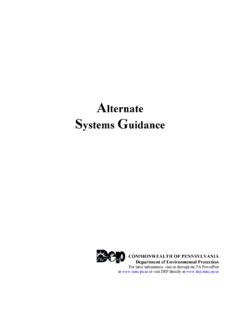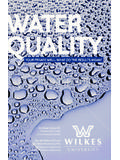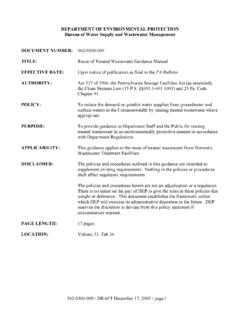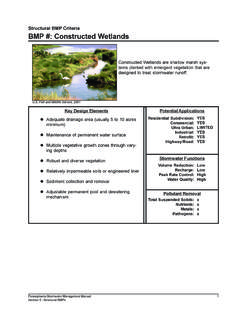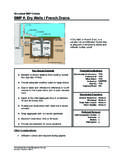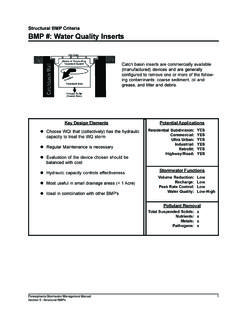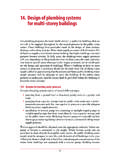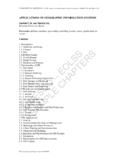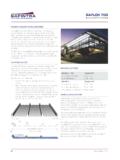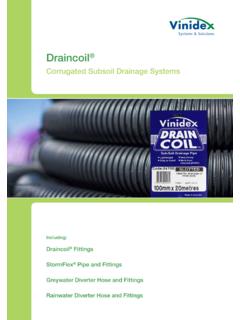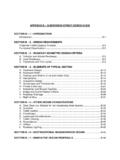Transcription of BMP #: Vegetated Swale - B.F. Environmental …
1 1 Pennsylvania Stormwater Management ManualSection 5 - Structural BMPsStructural BMP CriteriaBMP #: Vegetated SwaleA Vegetated Swale is a broad,shallow, trapezoidal or parabolicchannel, densely planted with avariety of trees, shrubs, and is designed to attenuate and insome cases infiltrate runoff volumefrom adjacent impervious surfaces,allowing some pollutants to settle outin the process. In steeper slopesituations, check dams are used tofurther enhance attenuation andinfiltration RemovalxxxxTotal Suspended Solids:Nutrients:Metals:Pathogens:Stormw ater Reduction:Recharge:Peak Rate Control:Water Quality:Potential ApplicationsResidential Subdivision:Commercial:Ultra Urban:Industrial:Retrofit:Highway/Road:Y ESYESNOLIMITEDYES*YESKey Design Elements!
2 Plant dense, low-growing native vegetation that iswater-resistant, drought and salt tolerant, providingsubstantial pollutant removal capabilities!Longitudinal slopes range from 2 to 6%!Side slopes range from 3:1 to 4:1!Bottom width of 2 to 8 feet (as determined byManning's Equation)!Treatment of the 1 inch storm event for waterquality, if designed properly!Check-dams can provide detention storage, aswell as enhanced volume control through infiltra-tion!Convey the 10-year storm event with a minimum of6 inches of freeboard!Designed for non-erosive velocities up to the 2-year storm event!Design to aesthetically fit into the landscape,where possible*Applicable with specific considerations to designOther Considerations!
3 Soil Investigation required2 Pennsylvania Stormwater Management ManualSection 5 - Structural BMPsFigure 1. Detail showing Vegetated swaleDescriptionVegetated swales are broad, shallow, earthen channels designed to slow runoff, promoteinfiltration, and filter pollutants and sediments in the process of conveying runoff. VegetatedSwales provide an environmentally superior alternative to conventional curb and gutterconveyance systems, while providing partially treated (pretreatment) and partially distributedstormwater flows to subsequent BMP s. Swales are often heavily Vegetated with a dense anddiverse selection of native, close-growing, water-resistant plants with high pollutant removalpotential.
4 The various pollutant removal mechanisms of a Swale include: filtering by the swalevegetation (both on side slopes and on bottom), filtering through a subsoil matrix, and/orinfiltration into the underlying soils with the full array of infiltration-oriented pollutant Vegetated Swale typically consists of a band of dense vegetation, underlain by at least 30inches of permeable soil over a 12 to 24 inch aggregate. The permeable soil media should havea minimum infiltration rate of inch per hour and contain a high level of organic material toenhance pollutant removal. A non-woven geotextile shall completely wrap the aggregate trench(See Infiltration Trench Section for further design guidelines).
5 3 Pennsylvania Stormwater Management ManualSection 5 - Structural BMPsA major concern when designing Vegetated Swales is to make sure that excessive stormwaterflows, slope, and other factors do not combine to produce erosive flows, which exceed VegetatedSwale capabilities. Use of check dams can enhanced Swale performance in such key feature of Vegetated Swale design is that they be well integrated into the landscapecharacter of the surrounding area. A Vegetated Swale can often enhance the aesthetic value of asite through the selection of appropriate native vegetation. Swales may also discreetly blend inwith landscaping features, especially when adjacent to Vegetated SwaleIn addition to the required elements of a Vegetated Swale , the Enhanced Vegetated Swaleincludes a 12 to 24 inch aggregate bed or trench, wrapped in a non-woven geotextile (SeeInfiltration Trench for further design guidelines).
6 This addition of an aggregate bed or trenchsubstantially increases volume control and water quality performance (both Soil Testing andInfiltration Protocols should be followed) although costs also are Vegetated Swales are best fitted for milder sloped swales where the addition of theaggregated bed system is recommended to make sure that the maximum allowable ponding timeof 48 hours is not exceeded. This aggregated bed system shall consist of at least 12 inches ofuniformly graded aggregate. Ideally, the underdrain system shall be designed like an infiltrationtrench. The subsurface trench should be comprised of terraced levels, though sloping trenchbottoms may also be acceptable.
7 The storage capacity of the infiltration trench may be added tothe surface storage volume to achieve the required storage of the 1-inch storm SwaleGrass swales are essentially conventional drainage ditches. They typically have milder side andlongitudinal slopes than their Vegetated counterparts. Grass swales are usually less expensivethan Vegetated swales. However, they provide far less infiltration and pollutant removalopportunities. Grass swales are to be used only as pretreatment for other structural of grass swales is often rate-based, as opposed to 2. Vegetated Swale along parking area4 Pennsylvania Stormwater Management ManualSection 5 - Structural BMPsFigure 4.
8 Vegetated Swale along road (Georgia BMP Manual)Figure 3. Vegetated Swale along residential area (Virginia Stormwater Management Handbook)Wet SwalesWet swales are essentially linear wetland cells. Their design often incorporates shallow,permanent pools or marshy conditions that can sustain wetland vegetation, which in turn providespotentially high pollutant removal. A high water table or poorly drained soils are a prerequisite forwet swales. The drawback with wet swales, at least in residential or commercial settings, is thatthey may promote mosquito breeding in the shallow standing water. Infiltration is Stormwater Management ManualSection 5 - Structural BMPsFigure 5.
9 Schematic showing Vegetated Swale along parking area (Cahill conceptual design)Applications Parking Commercial and light industrial facilities Roads and highways Residential developments Pretreatment for volume-based BMPs Alternative to curb/gutter and storm sewerDesign Considerations1. Vegetated Swales are sized to temporarily store and infiltrate the 1inch storm event, whileproviding conveyance for up to the 10-year storm with freeboard; flows for up to the 2-yearstorm are to be accommodated non-erosively. Swales shall maintain a maximum pondingdepth of 18 inches at the end point of the channel, with a 12-inch average maintainedthroughout.
10 Six inches of freeboard is recommended for the 10-year storm. Residencetimes between 5 and 9 minutes are acceptable for swales without check-dams. Themaximum ponding time is 48 hours, though 24 hours is more desirable (minimum of 30minutes). Swales shall generally be designed for non-erosive velocities up to the 2-yeardesign storm. Likewise, the design treatment depth of flow (for the 1 inch storm) shall notexceed approximately 2/3 the height of Swale vegetation. (The design velocity for the 1-inch storm shall be 1 foot per second.) Studies have shown that the maximum amount ofswale filtering occurs for water depths below 6 inches.
